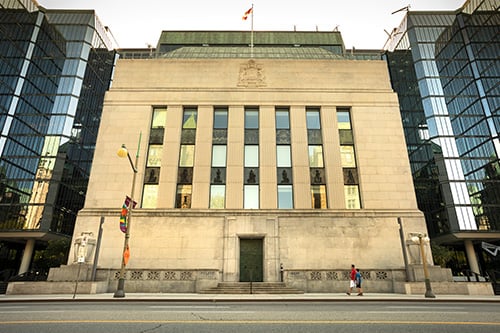The central bank will also be adjusting its quantitative easing program, reducing bond purchases to at least $4 billion a week

In its Oct. 28 policy decision, the Bank of Canada reiterated its pledge towards record-low rates for the foreseeable future, with the benchmark rate to remain at the effective lower bound of 0.25% until around 2023.
Despite Canada having entered what the central bank called the “recuperation phase” from the COVID-19 crisis, the BoC is predicting an annual growth rate of a mere 1% this quarter.
In its forecast, the bank also predicted that GDP won’t see a return to pre-pandemic levels for at least two years, hence the need to keep in force policy tools such as quantitative easing.
“The bank is maintaining its extraordinary forward guidance … recalibrating the QE program to shift purchases towards longer-term bonds, which have more direct influence on the borrowing rates that are most important for households and businesses,” the BoC said in a statement. “At the same time, total purchases will be gradually reduced to at least $4 billion a week.”
This will be a marked decline from the current $5-billion level.
“The Governing Council judges that, with these combined adjustments, the QE program is providing at least as much monetary stimulus as before,” the BoC said.
Prolonged economic recovery will require “extraordinary monetary policy support” that will likely last until “economic slack is absorbed so that the 2% inflation target is sustainably achieved,” the bank said. “We are committed to providing the monetary policy stimulus needed to support the recovery and achieve the inflation objective.”
Around 47% of economists polled by Finder said that the BoC’s benchmark rate will remain frozen until at least 2023. Approximately 13% said that the hold will last beyond then, while another 13% said the rate will move before 2022.
“We forecast that the Bank of Canada will keep the overnight rate target on hold until the second half of 2023 owing to the magnitude of the output gap, our forecasts for demand based on current and expected stimulus, our resulting forecast for inflation, and the Fed’s move to average inflation targeting,” said Brett House, deputy chief economist at Scotiabank.
Tony Stillo, director of Canada economics at Oxford Economic, is among those predicting an even longer hold period.
“We think fears that excessive monetary stimulus will stoke higher inflation are misplaced and expect inflation will remain subdued, with a greater risk of deflation due to weak aggregate demand and slack in the economy,” Stillo said. “Accordingly, we expect the policy rate to remain at 0.25% until early 2024 before a gradual tightening begins.”



